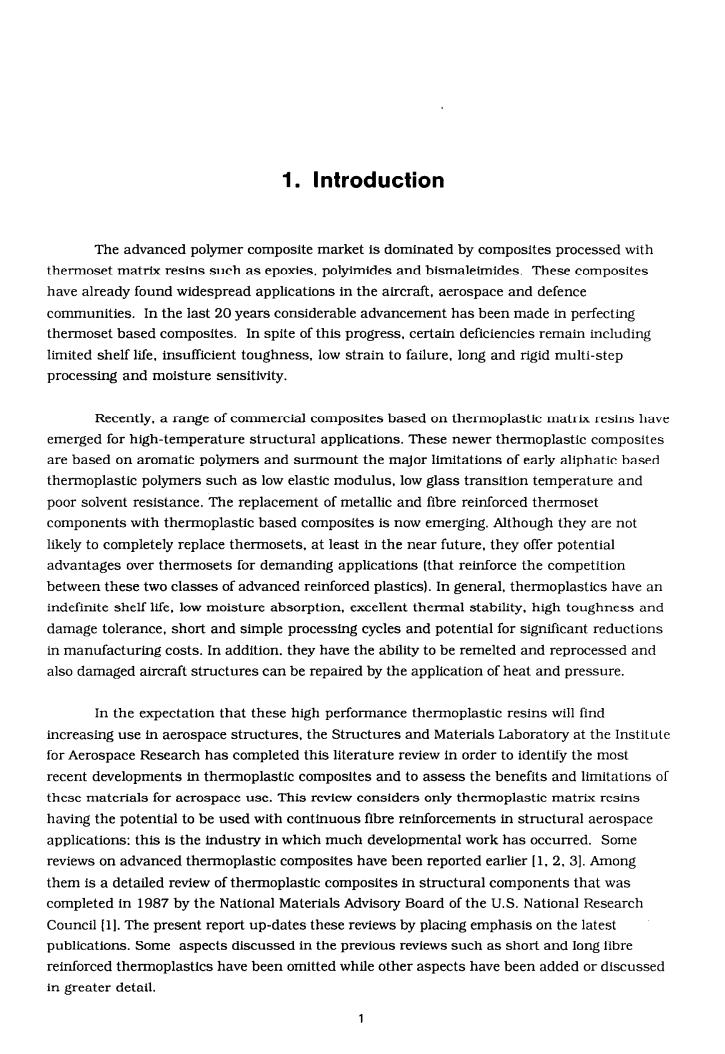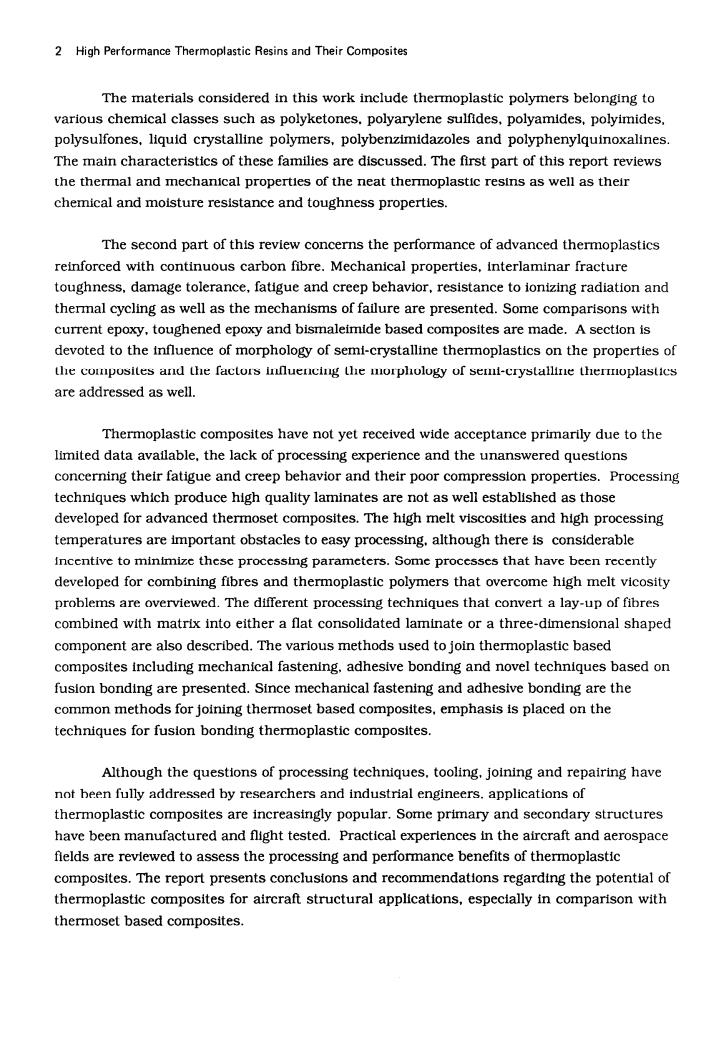
1.Introduction The advanced polymer composite market is dominated by composites processed with thermoset matrix resins such as epoxies.polyimides and bismaleimides.These composites have already found widespread applications in the aircraft,aerospace and defence communities.In the last 20 years considerable advancement has been made in perfecting thermoset based composites.In spite of this progress.certain deficiencies remain including limited shelf life,insufficient toughness.low strain to failure,long and rigid multi-step processing and moisture sensitivity. Recently.a range of commercial composites based on thermoplastic matrix resins have emerged for high-temperature structural applications.These newer thermoplastic composites are based on aromatic polymers and surmount the major limitations of early aliphatic based thermoplastic polymers such as low elastic modulus,low glass transition temperature and poor solvent resistance.The replacement of metallic and fibre reinforced thermoset components with thermoplastic based composites is now emerging.Although they are not likely to completely replace thermosets,at least in the near future,they offer potential advantages over thermosets for demanding applications(that reinforce the competition between these two classes of advanced reinforced plastics).In general,thermoplastics have an indefinite shelf life.low moisture absorption,excellent thermal stability,high toughness and damage tolerance,short and simple processing cycles and potential for significant reductions in manufacturing costs.In addition.they have the ability to be remelted and reprocessed and also damaged aircraft structures can be repaired by the application of heat and pressure. In the expectation that these high performance thermoplastic resins will find increasing use in aerospace structures,the Structures and Materials Laboratory at the Institute for Aerospace Research has completed this literature review in order to identify the most recent developments in thermoplastic composites and to assess the benefits and limitations of thesc matcrials for acrospacc usc.This revicw considers only thermoplastic matrix rcsins having the potential to be used with continuous fibre reinforcements in structural aerospace applications:this is the industry in which much developmental work has occurred.Some reviews on advanced thermoplastic composites have been reported earlier [1.2.3].Among them is a detailed review of thermoplastic composites in structural components that was completed in 1987 by the National Materials Advisory Board of the U.S.National Research Council [1l.The present report up-dates these reviews by placing emphasis on the latest publications.Some aspects discussed in the previous revlews such as short and long libre reinforced thermoplastics have been omitted while other aspects have been added or discussed in greater detail. 1
1. Introduction The advanced polymer composite market is dominated by composites processed with thermoset matrix resins such as epoxies, polyimides and bismaleimides. These composites have already found widespread applications in the aircraft, aerospace and defence communities. In the last 20 years considerable advancement has been made in perfecting thermoset based composites. In spite of this progress, certain deficiencies remain including limited shelf life, insufficient toughness, low strain to failure, long and rigid multi-step processing and moisture sensitivity. Recently, a range of commercial composites based on thermoplastic matrix resins have emerged for high-temperature structural applications. These newer thermoplastic composites are based on aromatic polymers and surmount the major limitations of early aliphatic based thermoplastic polymers such as low elastic modulus, low glass transition temperature and poor solvent resistance. The replacement of metallic and fibre reinforced thermoset components with thermoplastic based composites is now emerging. Although they are not likely to completely replace thermosets, at least in the near future, they offer potential advantages over thermosets for demanding applications (that reinforce the competition between these two classes of advanced reinforced plastics). In general, thermoplastics have an indefinite shelf life, low moisture absorption, excellent thermal stability, high toughness and damage tolerance, short and simple processing cycles and potential for significant reductions in manufacturing costs. In addition, they have the ability to be remelted and reprocessed and also damaged aircraft structures can be repaired by the application of heat and pressure. In the expectation that these high performance thermoplastic resins will find increasing use in aerospace structures, the Structures and Materials Laboratory at the Institute for Aerospace Research has completed this literature review in order to identify the most recent developments in thermoplastic composites and to assess the benefits and limitations of these materials for aerospace use. This review considers only thermoplastic matrix resins having the potential to be used with continuous flbre reinforcements in structural aerospace applications; this is the industry in which much developmental work has occurred. Some reviews on advanced thermoplastic composites have been reported earlier [ 1, 2. 31. Among them is a detailed review of thermoplastic composites in structural components that was completed in 1987 by the National Materials Advisory Board of the U.S. National Research Council (11. The present report up-dates these reviews by placing emphasis on the latest publications. Some aspects discussed in the previous reviews such as short and long fibre reinforced thermoplastics have been omitted while other aspects have been added or discussed in greater detail

2 High Performance Thermoplastic Resins and Their Composites The materials considered in this work include thermoplastic polymers belonging to various chemical classes such as polyketones.polyarylene sulfides,polyamides,polyimides. polysulfones,liquid crystalline polymers,polybenzimidazoles and polyphenylquinoxalines. The main characteristics of these families are discussed.The first part of this report reviews the thermal and mechanical properties of the neat thermoplastic resins as well as their chemical and moisture resistance and toughness properties. The second part of this review concerns the performance of advanced thermoplastics reinforced with continuous carbon fibre.Mechanical properties,interlaminar fracture toughness.damage tolerance,fatigue and creep behavior,resistance to ionizing radiation and thermal cycling as well as the mechanisms of failure are presented.Some comparisons with current epoxy,toughened epoxy and bismaleimide based composites are made.A section is devoted to the influence of morphology of semi-crystalline thermoplastics on the properties of the composites and the factors influencing the morphology of semi-crystalline thermoplastics are addressed as well. Thermoplastic composites have not yet received wide acceptance primarily due to the limited data available,the lack of processing experience and the unanswered questions concerning their fatigue and creep behavior and their poor compression properties.Processing techniques which produce high quality laminates are not as well established as those developed for advanced thermoset composites.The high melt viscosities and high processing temperatures are important obstacles to easy processing,although there is considerable incentive to minimizc thesc processing parameters.Some processes that have been recently developed for combining fibres and thermoplastic polymers that overcome high melt vicosity problems are overviewed.The different processing techniques that convert a lay-up of fibres combined with matrix into either a flat consolidated laminate or a three-dimensional shaped component are also described.The various methods used to join thermoplastic based composites including mechanical fastening,adhesive bonding and novel techniques based on fusion bonding are presented.Since mechanical fastening and adhesive bonding are the common methods for joining thermoset based composites,emphasis is placed on the techniques for fusion bonding thermoplastic composites. Although the questions of processing techniques.tooling.joining and repairing have not been fully addressed by researchers and industrial engineers.applications of thermoplastic composites are increasingly popular.Some primary and secondary structures have been manufactured and flight tested.Practical experiences in the aircraft and aerospace fields are revlewed to assess the processing and performance benefits of thermoplastic composites.The report presents conclusions and recommendations regarding the potential of thermoplastic composites for aircraft structural applications,especially in comparison with thermoset based composites
2 High Performance Thermoplastic Resins and Their Composites The materials considered in this work include thermoplastic polymers belonging to various chemical classes such as polyketones. polyarylene sulfides, polyamides, polyimides. polysulfones. liquid crystalline polymers, polybenzimidazoles and polyphenylquinoxalines. The main characteristics of these families are discussed. The first part of this report reviews the thermal and mechanical properties of the neat thermoplastic resins as well as their chemical and moisture resistance and toughness properties. The second part of this review concerns the performance of advanced thermoplastics reinforced with continuous carbon fibre. Mechanical properties, interlaminar fracture toughness, damage tolerance, fatigue and creep behavior, resistance to ionizing radiation and thermal cycling as well as the mechanisms of failure are presented. Some comparisons with current epoxy, toughened epoxy and bismaleimide based composites are made. A section is devoted to the influence of morphology of semi-crystalline thermoplastics on the properties of the composites and the factors influencing the morphology of semi-crystalline thermoplastics are addressed as well. Thermoplastic composites have not yet received wide acceptance primarily due to the limited data available, the lack of processing experience and the unanswered questions concerning their fatigue and creep behavior and their poor compression properties. Processing techniques which produce high quality laminates are not as well established as those developed for advanced thermoset composites. The high melt viscosities and high processing temperatures are important obstacles to easy processing, although there is considerable incentive to minimize these processing parameters. Some processes that have been recently developed for combining fibres and thermoplastic polymers that overcome high melt vicosity problems are overviewed. The different processing techniques that convert a lay-up of fibres combined with matrix into either a flat consolidated laminate or a three-dimensional shaped component are also described. The various methods used to join thermoplastic based composites including mechanical fastening, adhesive bonding and novel techniques based on fusion bonding are presented. Since mechanical fastening and adhesive bonding are the common methods for joining thermoset based composites, emphasis is placed on the techniques for fusion bonding thermoplastic composites. Although the questions of processing techniques, tooling, joining and repairing have not been fully addressed by researchers and industrial engineers, applications of thermoplastic composites are increasingly popular. Some primary and secondary structures have been manufactured and flight tested. Practical experiences in the aircraft and aerospace fields are reviewed to assess the processing and performance benefits of thermoplastic composites. The report presents conclusions and recommendations regarding the potential of thermoplastic composites for aircraft structural applications, especially in comparison with thermoset based composites